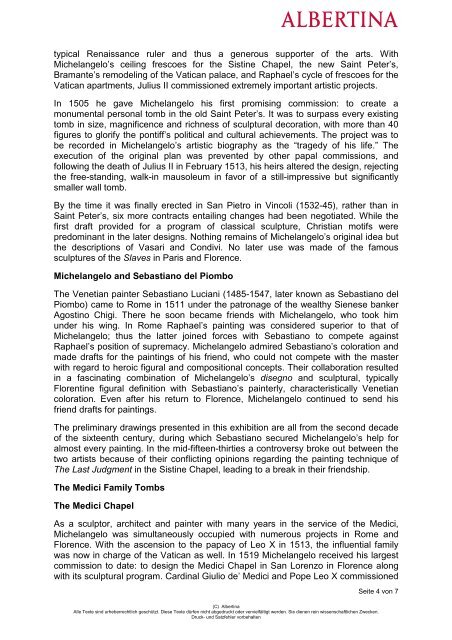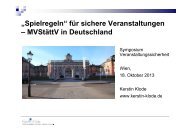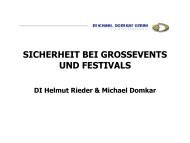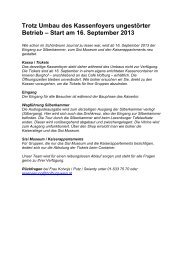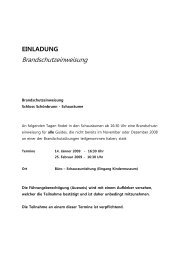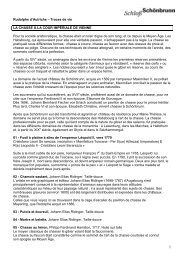Michelangelo. The drawings of a genius - Freizeitbetriebe-wien.at
Michelangelo. The drawings of a genius - Freizeitbetriebe-wien.at
Michelangelo. The drawings of a genius - Freizeitbetriebe-wien.at
You also want an ePaper? Increase the reach of your titles
YUMPU automatically turns print PDFs into web optimized ePapers that Google loves.
typical Renaissance ruler and thus a generous supporter <strong>of</strong> the arts. With<br />
<strong>Michelangelo</strong>’s ceiling frescoes for the Sistine Chapel, the new Saint Peter’s,<br />
Bramante’s remodeling <strong>of</strong> the V<strong>at</strong>ican palace, and Raphael’s cycle <strong>of</strong> frescoes for the<br />
V<strong>at</strong>ican apartments, Julius II commissioned extremely important artistic projects.<br />
In 1505 he gave <strong>Michelangelo</strong> his first promising commission: to cre<strong>at</strong>e a<br />
monumental personal tomb in the old Saint Peter’s. It was to surpass every existing<br />
tomb in size, magnificence and richness <strong>of</strong> sculptural decor<strong>at</strong>ion, with more than 40<br />
figures to glorify the pontiff’s political and cultural achievements. <strong>The</strong> project was to<br />
be recorded in <strong>Michelangelo</strong>’s artistic biography as the “tragedy <strong>of</strong> his life.” <strong>The</strong><br />
execution <strong>of</strong> the original plan was prevented by other papal commissions, and<br />
following the de<strong>at</strong>h <strong>of</strong> Julius II in February 1513, his heirs altered the design, rejecting<br />
the free-standing, walk-in mausoleum in favor <strong>of</strong> a still-impressive but significantly<br />
smaller wall tomb.<br />
By the time it was finally erected in San Pietro in Vincoli (1532-45), r<strong>at</strong>her than in<br />
Saint Peter’s, six more contracts entailing changes had been negoti<strong>at</strong>ed. While the<br />
first draft provided for a program <strong>of</strong> classical sculpture, Christian motifs were<br />
predominant in the l<strong>at</strong>er designs. Nothing remains <strong>of</strong> <strong>Michelangelo</strong>’s original idea but<br />
the descriptions <strong>of</strong> Vasari and Condivi. No l<strong>at</strong>er use was made <strong>of</strong> the famous<br />
sculptures <strong>of</strong> the Slaves in Paris and Florence.<br />
<strong>Michelangelo</strong> and Sebastiano del Piombo<br />
<strong>The</strong> Venetian painter Sebastiano Luciani (1485-1547, l<strong>at</strong>er known as Sebastiano del<br />
Piombo) came to Rome in 1511 under the p<strong>at</strong>ronage <strong>of</strong> the wealthy Sienese banker<br />
Agostino Chigi. <strong>The</strong>re he soon became friends with <strong>Michelangelo</strong>, who took him<br />
under his wing. In Rome Raphael’s painting was considered superior to th<strong>at</strong> <strong>of</strong><br />
<strong>Michelangelo</strong>; thus the l<strong>at</strong>ter joined forces with Sebastiano to compete against<br />
Raphael’s position <strong>of</strong> supremacy. <strong>Michelangelo</strong> admired Sebastiano’s color<strong>at</strong>ion and<br />
made drafts for the paintings <strong>of</strong> his friend, who could not compete with the master<br />
with regard to heroic figural and compositional concepts. <strong>The</strong>ir collabor<strong>at</strong>ion resulted<br />
in a fascin<strong>at</strong>ing combin<strong>at</strong>ion <strong>of</strong> <strong>Michelangelo</strong>’s disegno and sculptural, typically<br />
Florentine figural definition with Sebastiano’s painterly, characteristically Venetian<br />
color<strong>at</strong>ion. Even after his return to Florence, <strong>Michelangelo</strong> continued to send his<br />
friend drafts for paintings.<br />
<strong>The</strong> preliminary <strong>drawings</strong> presented in this exhibition are all from the second decade<br />
<strong>of</strong> the sixteenth century, during which Sebastiano secured <strong>Michelangelo</strong>’s help for<br />
almost every painting. In the mid-fifteen-thirties a controversy broke out between the<br />
two artists because <strong>of</strong> their conflicting opinions regarding the painting technique <strong>of</strong><br />
<strong>The</strong> Last Judgment in the Sistine Chapel, leading to a break in their friendship.<br />
<strong>The</strong> Medici Family Tombs<br />
<strong>The</strong> Medici Chapel<br />
As a sculptor, architect and painter with many years in the service <strong>of</strong> the Medici,<br />
<strong>Michelangelo</strong> was simultaneously occupied with numerous projects in Rome and<br />
Florence. With the ascension to the papacy <strong>of</strong> Leo X in 1513, the influential family<br />
was now in charge <strong>of</strong> the V<strong>at</strong>ican as well. In 1519 <strong>Michelangelo</strong> received his largest<br />
commission to d<strong>at</strong>e: to design the Medici Chapel in San Lorenzo in Florence along<br />
with its sculptural program. Cardinal Giulio de’ Medici and Pope Leo X commissioned<br />
Seite 4 von 7<br />
(C) Albertina<br />
Alle Texte sind urheberrechtlich geschützt. Diese Texte dürfen nicht abgedruckt oder vervielfältigt werden. Sie dienen rein wissenschaftlichen Zwecken.<br />
Druck- und S<strong>at</strong>zfehler vorbehalten


